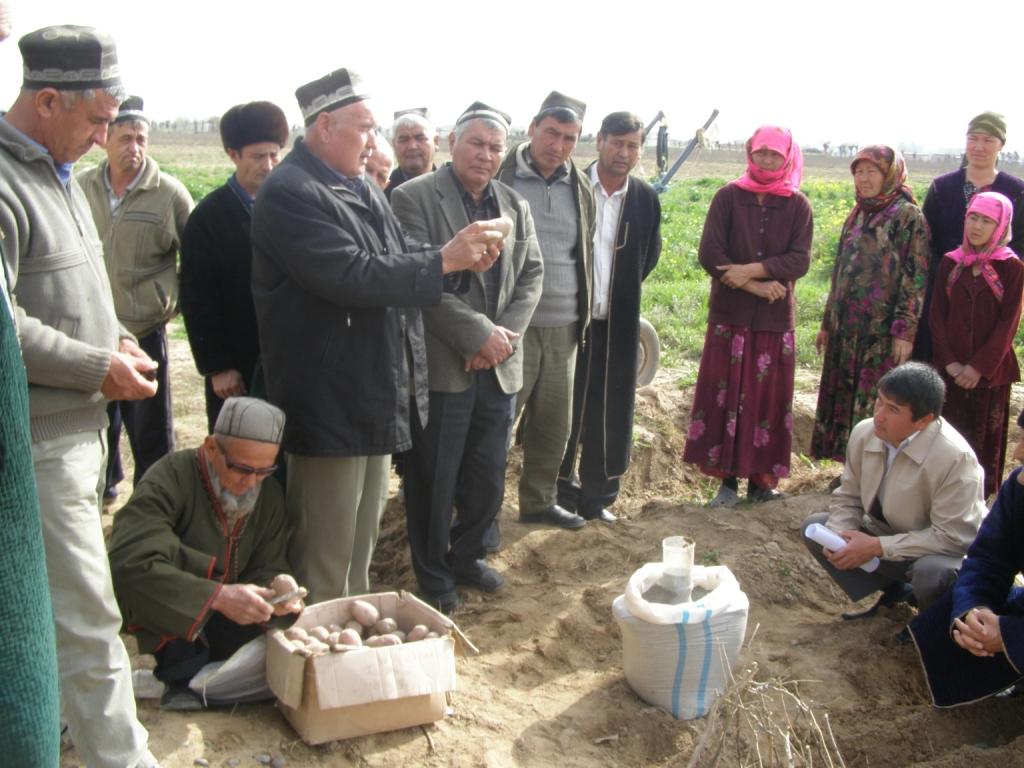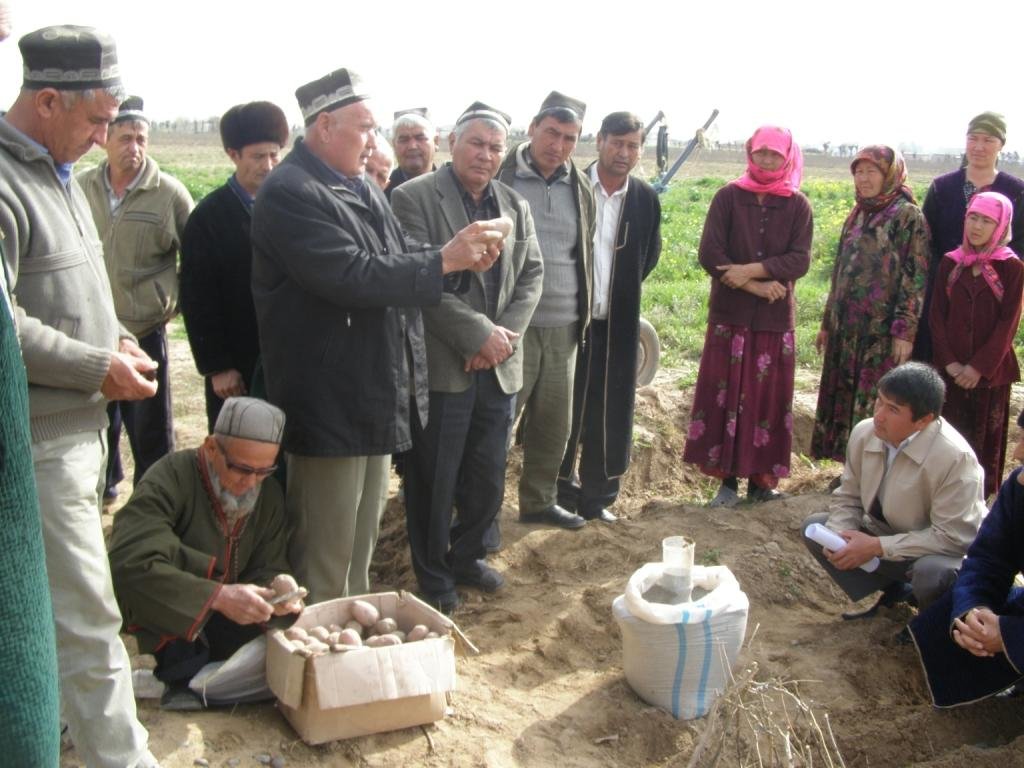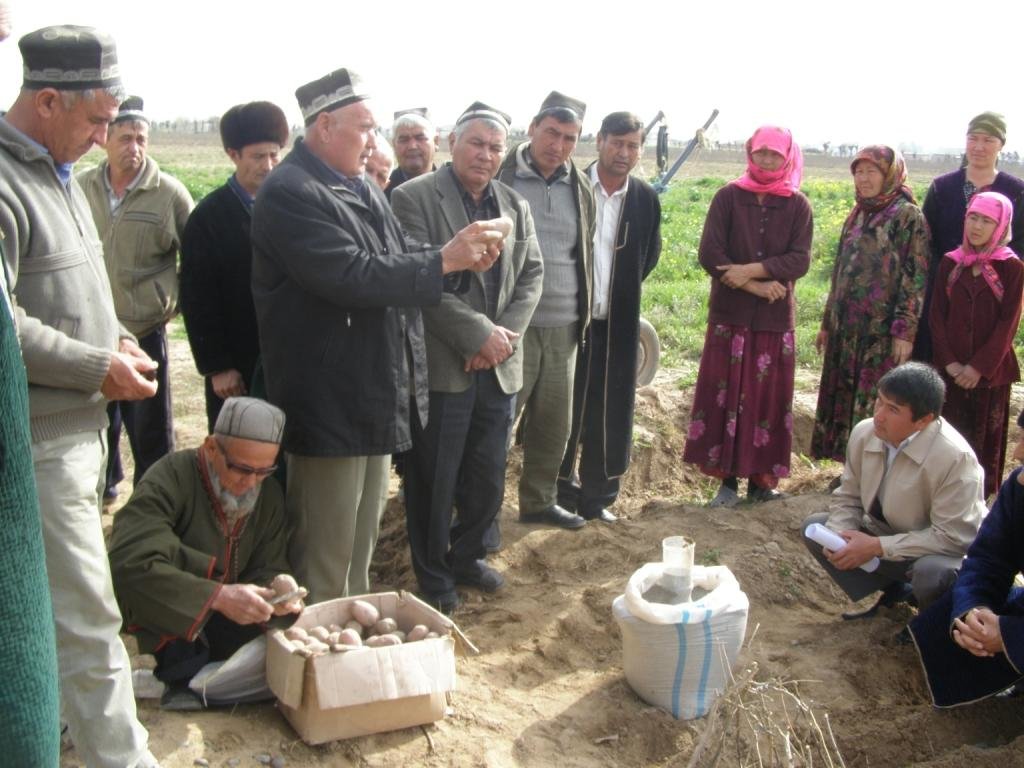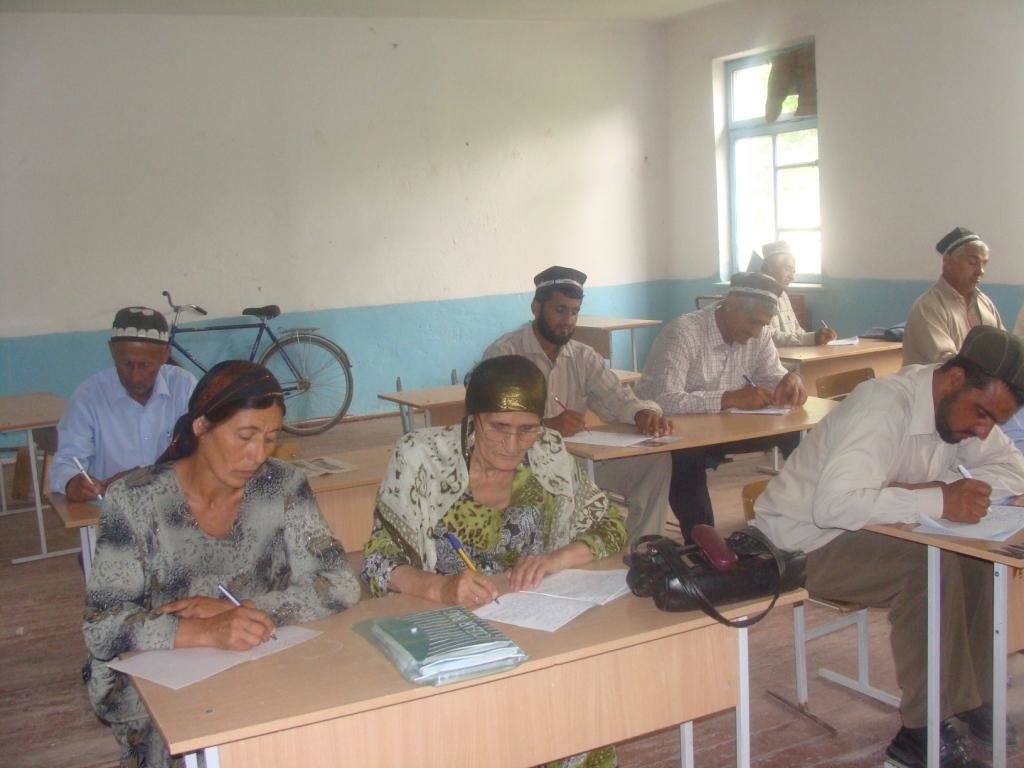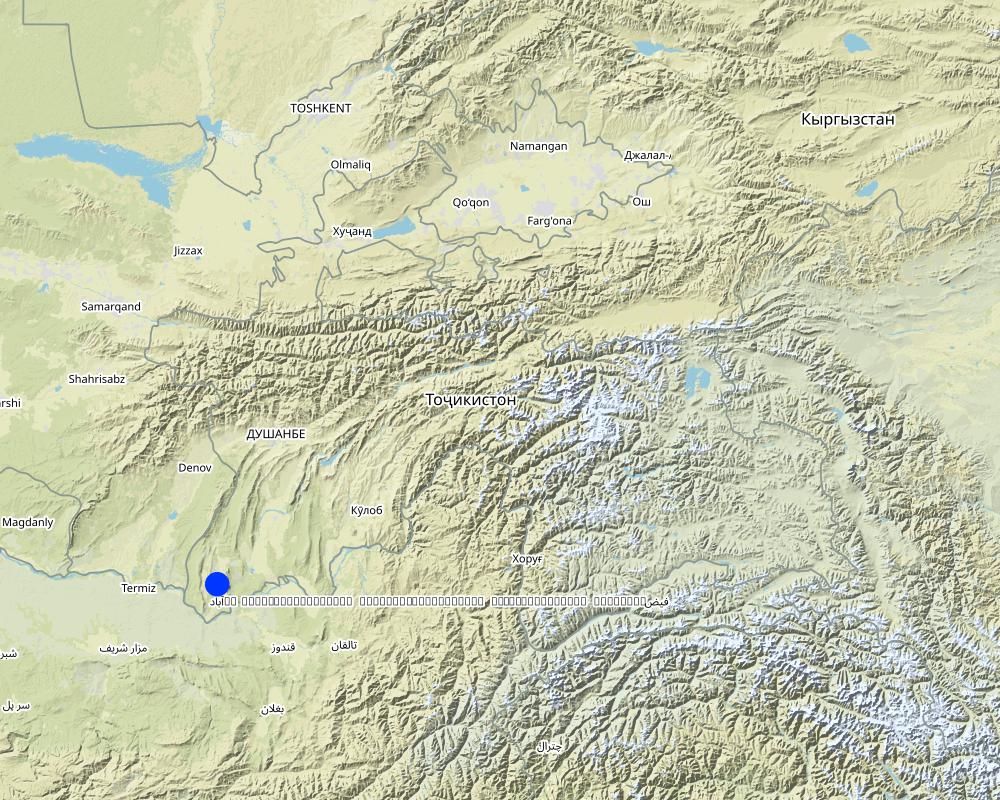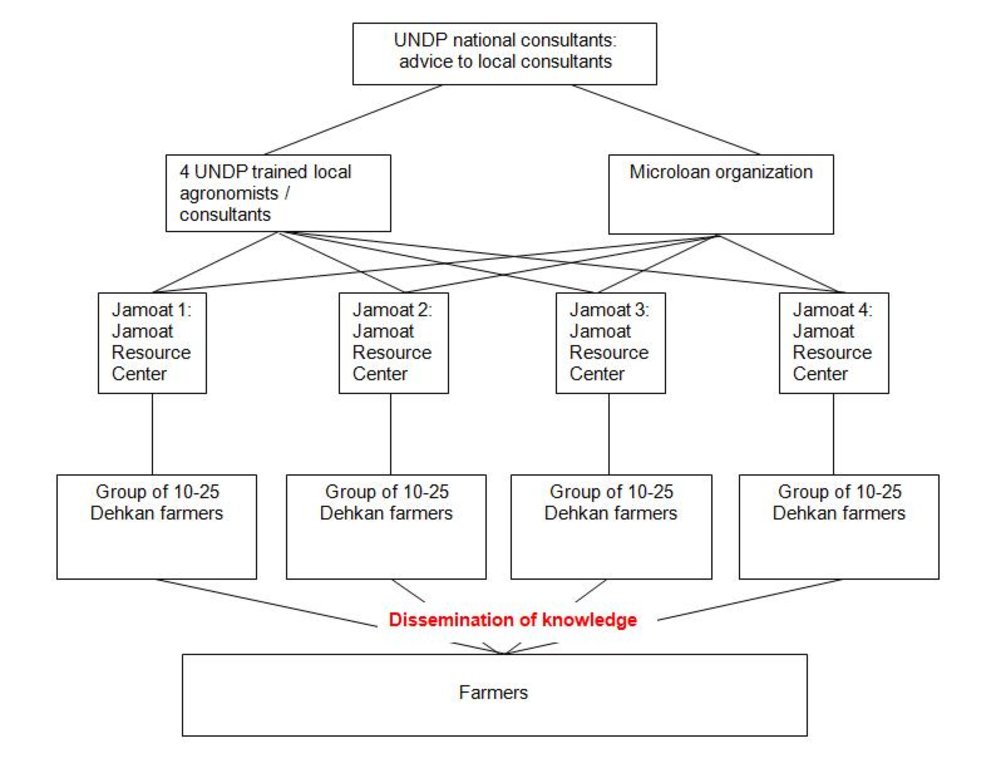Central Asian Countries Initiative for Sustainable Land Management (CACILM) [Tadjikistan]
- Création :
- Mise à jour :
- Compilateur : Firdavs Faizulloev
- Rédacteur : –
- Examinateurs : David Streiff, Alexandra Gavilano, Joana Eichenberger
Фермерские полевые школы
approaches_2439 - Tadjikistan
- Résumé complet en PDF
- Résumé complet en PDF pour impression
- Résumé complet dans le navigateur
- Résumé complet (non formaté)
- Фермерские полевые школы: 6 juillet 2017 (inactive)
- Central Asian Countries Initiative for Sustainable Land Management (CACILM): 6 juillet 2017 (inactive)
- Central Asian Countries Initiative for Sustainable Land Management (CACILM): 8 août 2017 (inactive)
- Central Asian Countries Initiative for Sustainable Land Management (CACILM): 2 novembre 2021 (public)
Voir les sections
Développer tout Réduire tout1. Informations générales
1.2 Coordonnées des personnes-ressources et des institutions impliquées dans l'évaluation et la documentation de l'Approche
Spécialiste GDT:
Spécialiste GDT:
Spécialiste GDT:
Urakov Buran
UNDP, Farmers Field School Consultant
Tadjikistan
Nom du projet qui a facilité la documentation/ l'évaluation de l'Approche (si pertinent)
Central Asian Countries Initiative for Land Management (CACILM I)Nom du projet qui a facilité la documentation/ l'évaluation de l'Approche (si pertinent)
Pilot Program for Climate Resilience, Tajikistan (WB / PPCR)Nom du ou des institutions qui ont facilité la documentation/ l'évaluation de l'Approche (si pertinent)
United Nations Development Program (United Nations Development Program) - TadjikistanNom du ou des institutions qui ont facilité la documentation/ l'évaluation de l'Approche (si pertinent)
CDE Centre for Development and Environment (CDE Centre for Development and Environment) - Suisse1.3 Conditions relatives à l'utilisation par WOCAT des données documentées
Quand les données ont-elles été compilées (sur le terrain)?
10/03/2010
Le compilateur et la(les) personne(s) ressource(s) acceptent les conditions relatives à l'utilisation par WOCAT des données documentées:
Oui
1.4 Références au(x) questionnaire(s) sur les Technologies de GDT
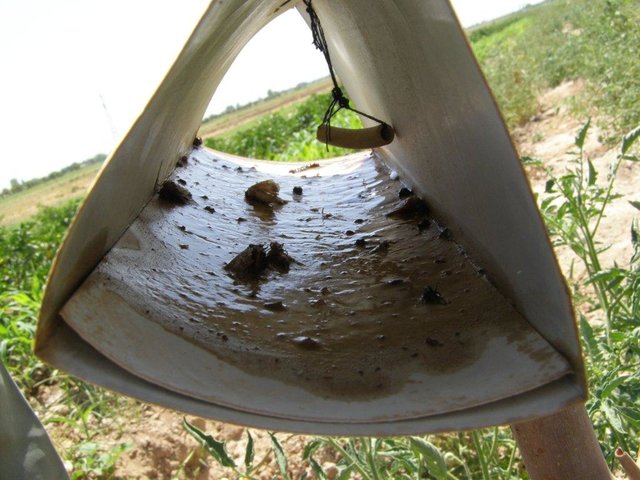
Pest management with pheromone insect traps [Tadjikistan]
Coloured pheromone traps are set up in agricultural fields to attract and eradicate flying insect pests.
- Compilateur : Firdavs Faizulloev
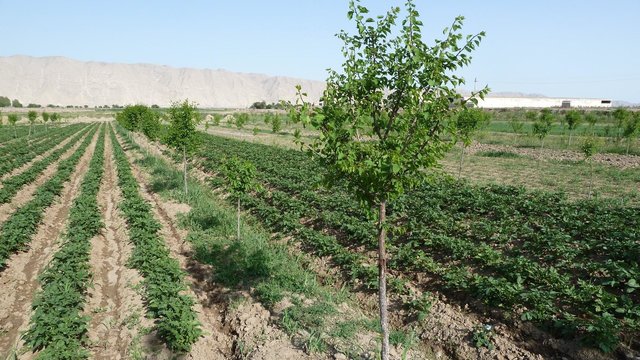
Rehabilitation of poor soils through agroforestry [Tadjikistan]
An agroforestry system with peach, plum, sweet cherry and persimmon trees was established on a plot of land, with poor soil quality.
- Compilateur : Natalia Mityakova
2. Description de l'Approche de GDT
2.1 Courte description de l'Approche
Farmer Field Schools (FFS) are held to fill farmer's gaps in knowledge on the use of sustainable agricultural technologies, efficient irrigation water use and prevention of land degradation using trials tailored to local conditions.
2.2 Description détaillée de l'Approche
Description détaillée de l'Approche:
Aims / objectives: Farmer field schools are part of the UNDP-GEF project on “Demonstrating Local Responses to Combating Land Degradation and Improving Sustainable Land Management in SW Tajikistan”. They were established with the aim to address the dissemination of sustainable agricultural technologies, and the introduction of new crops. Currently, many farmers in Tajikistan may not previously have been farmers during Soviet times and therefore may lack detailed agricultural knowledge and experience.
Methods: The FFS training is voluntary and the opportunities to attend are announced at Jamoat level. Each year 4 different groups, each comprising 10 to 20 farmers are formed in 4 different Jamoats. The learning comprises a range of activities from classroom teaching to hands-on field experience. The content of the training sessions are effectively adapted to the relevant season and crops as well as to the pests that may occur. The field school addresses some of the following topics; cultivation of winter wheat, potatoes, tomatoes and melons, adequate post harvest handling, use of trees and shelterbelts, generation of quality seeds, pest management, efficient use of irrigation water, etc. The field from which the FFS participants learn about agriculture in practice is a 0.5 ha plot provided by one of the farmers.
Stages of implementation: Before the start of the FFS, 4 local agronomists from target Jamoats were recruited by UNDP and sent on a study tour to Russia. These agronomists in their capacity as a Local FFS Consultant started running FFSs in each Jamoat. Initially, in conjunction with the National FFS Consultant of the SLM project, the local consultants organised several meetings with local farmers in order to identify their training needs. Taking into account the needs of farmers the curricula was prepared and the training schedule was agreed with the farmers/participants.
Role of stakeholders: The project engaged women who are generally considered landless and vulnerable. They were involved in the demo plots on the basis of agreement signed between a local women’s group and a farmer, who owned the land. According to this agreement 70% of the harvest is distributed among the women, and 30% remains for farmer. In addition, many training sessions on pest management, planting of tomatoes, potatoes etc were delivered to women at the demo plot. To ensure food security at the household level training on canning, preparation of juice and how to make jam were conducted. However, more male than female farmers participated in the FFS. This is linked to the fact that the role of male farmers on Dehkan farms is to take decisions on cropping patterns and instruct other farmers. Therefore better dissemination of knowledge is expected from male farmers participating.
Other important information: The project has been efficient in providing micro-loans through an agreement with the micro-loan organisation “Rushdi Obshoron” for agricultural purposes in all four Jamoats, In total, 100,000USD has been distributed to 4 Jamoats.
2.3 Photos de l'approche
2.5 Pays/ région/ lieux où l'Approche a été appliquée
Pays:
Tadjikistan
Région/ Etat/ Province:
Khatlon
Autres spécifications du lieu :
Shaartuz
Map
×2.6 Dates de début et de fin de l'Approche
Indiquez l'année de démarrage:
2007
Date (année) de fin de l'Approche (si l'Approche n'est plus appliquée):
2011
2.7 Type d'Approche
- fondé sur un projet/ programme
2.8 Principaux objectifs de l'Approche
The Approach focused mainly on other activities than SLM (agricultural production, market regulation, value chain development, seed multiplication )
The main aim of the approach is to support a change in mindset from a collective farming (Kolhoz) approach led by the state, onto private farmers putting more responsibility with the land users themselves. Since the collapse of the Soviet Union, many collective farms disintegrated and as a result of land reforms, the Dehkan farms came into being. People without an agricultural background could set up their own Dehkan farms and become farmers. However, a lack of knowledge and expertise frequently led to inappropriate land use which has contributed to land degradation. The objectives of FFS are to provide training sessions to farmers to improve their knowledge of better farming practices and the more rational use of land and water resources.
The SLM Approach addressed the following problems: lack of technical agricultural and ‘market economy’ knowledge, poverty
2.9 Conditions favorisant ou entravant la mise en œuvre de la(des) Technologie(s) appliquée(s) sous l'Approche
normes et valeurs sociales/ culturelles/ religieuses
- entrave
Many women in the region do not own their own land and can therefore be very vulnerable
Treatment through the SLM Approach: They were involved in the FFS receiving special training on pest management, planting of tomatoes, potatoes, vegetable canning, preparation of juice etc. A benefit sharing agreement was signed between the women’s group and the farmer who owned the land
disponibilité/ accès aux ressources et services financiers
- entrave
Lack of financial resources to buy fuel, fertilisers, livestock etc.
Treatment through the SLM Approach: A microloan organisation is providing credit loans from 2000-9000 Somoni (450-2,000 USD)
cadre juridique (régime foncier, droits d'utilisation des terres et de l'eau)
- entrave
The existing land ownership, land use rights / water rights moderately hindered the approach implementation Initially, farmers had no freedom to farm, meaning they were not allowed to choose which crops they would grow, however, after the economic crisis this changed.
connaissances sur la GDT, accès aux supports techniques
- entrave
In general farmer’s agricultural knowledge is weak. Especially as after the collapse of the Soviet Union anybody could get some land and become a farmer, even people who did not have a traditional farming background and therefore no agricultural knowledge
Treatment through the SLM Approach: In the field schools farmers are receiving training about new agricultural technologies and have the chance to get advice about their particular problems
autre
- entrave
No quality seeds were available
Treatment through the SLM Approach: UNDP provided seeds and ensured that a multiplication mechanism took place
3. Participation et rôles des parties prenantes impliquées dans l'Approche
3.1 Parties prenantes impliquées dans l'Approche et rôles
- exploitants locaux des terres / communautés locales
Local agronomists from Jamoat level were sent to Russia on a study trip to learn from Russian experiences with sustainable land management
Landless women, individual farmers
Only 1/3 of the participants were women. This is linked to the fact that the role of male farmers on Dehkan farms is to take decisions on cropping patterns and instruct other farmers. Therefore better dissemination of knowledge is expected from male farmers participating.
Landless women who are very vulnerable.
- Spécialistes de la GDT/ conseillers agricoles
International specialists
National and local level consultants
- ONG
National agronomists working as consultants for UNDP
- organisation internationale
UNDP
Si plusieurs parties prenantes sont impliquées, indiquez l'organisme chef de file ou l'institution responsable:
UNDP
3.2 Participation des exploitants locaux des terres/ communautés locales aux différentes phases de l'Approche
| Participation des exploitants locaux des terres/ communautés locales | Spécifiez qui était impliqué et décrivez les activités | |
|---|---|---|
| initiation/ motivation | passive | |
| planification | passive | |
| mise en œuvre | passive | Farmers only participated in FFS and were not involved in developing the content of training |
| suivi/ évaluation | interactive | No monitoring of the theoretical part of the approach took place, monitoring of land users success in applying the taught practices included interactive participation of land users. |
| Research | interactive | Some research on crop performance was undertaken with interactive involvement of land users. |
3.3 Diagramme/ organigramme (si disponible)
Description:
Before the start of the FFS 4 local agronomists from target Jamoats were recruited by UNDP and sent on a study tour to Russia. These local FFS consultants then started running a FFS in each Jamoat.
Auteur:
Julie Zähringer (Baumackerstr. 51, 8050 Zürich)
3.4 Prises de décision pour la sélection de la Technologie/ des Technologies
Indiquez qui a décidé de la sélection de la Technologie/ des Technologies à mettre en œuvre:
- principalement les spécialistes de la GDT, après consultation des exploitants des terres
Expliquez:
Decisions on the method of implementing the SLM Technology were made by mainly by SLM specialists with consultation of land users
4. Soutien technique, renforcement des capacités et gestion des connaissances
4.1 Renforcement des capacités/ formation
Une formation a-t-elle été dispensée aux exploitants des terres/ autres parties prenantes?
Oui
Spécifiez qui a été formé:
- exploitants des terres
- personnels/ conseillers de terrain
Formats de la formation:
- sur le tas
- entre agriculteurs (d'exploitants à exploitants)
- zones de démonstration
- cours
Thèmes abordés:
Sustainable irrigation water use, integrated crop management, tree planting for biodrainage, preventing gully formation, crop storage, effective seed production, pest management
4.2 Service de conseils
Les exploitants des terres ont-ils accès à un service de conseils?
Oui
Spécifiez si le service de conseils est fourni:
- dans les champs des exploitants?
Décrivez/ commentez:
Farmer Field Schools: Key elements: Classroom courses, Farmer to farmer visits, Demonstration plots; Research is done on demonstration plots. Farmer to farmer visits are needed for an exchange of experience between different farmers.
Advisory service is quite adequate to ensure the continuation of land conservation activities; As they were provided with adequate training, the local level consultants are now able to continue holding training in farmer field schools. If the provision of micro-loans and the pay-back scheme keep working, funding will be available to ensure continuation.
4.3 Renforcement des institutions (développement organisationnel)
Des institutions ont elles été mises en place ou renforcées par le biais de l'Approche?
- oui, modérément
Spécifiez à quel(s) niveau(x), ces institutions ont été renforcées ou mises en place:
- local
Précisez le type de soutien:
- financier
- renforcement des capacités/ formation
Donnez plus de détails:
infrastructure, classrooms
4.4 Suivi et évaluation
Le suivi et l'évaluation font ils partie de l'Approche? :
Oui
Commentaires:
technical aspects were regular monitored by project staff through measurements; indicators: on farm productivity
bio-physical aspects were ad hoc monitored by land users through observations; indicators: market situation
economic / production aspects were regular monitored by project staff through observations; indicators: None
no. of land users involved aspects were regular monitored by project staff through measurements; indicators: None
There were no changes in the Approach as a result of monitoring and evaluation: None
There were several changes in the Technology as a result of monitoring and evaluation: Exchange of experiences between different Jamoats (Jamoats differed in types of crops cultivated).
4.5 Recherche
La recherche a-t-elle fait partie intégrante de l’Approche?
Oui
Spécifiez les thèmes:
- économie/ marketing
- écologie
- technologie
Donnez plus de détails et indiquez qui a mené ces recherches:
Experiments about intercropping of different crop species. Local consultants also undertook research on marketing of different crops, which crop should be grown, and when for example, in order to achieve the best prices.
Research was carried out on-farm
5. Financement et soutien matériel externe
5.1 Budget annuel de la composante GDT de l'Approche
Si le budget annuel précis n'est pas connu, indiquez une fourchette:
- 100 000-1 000 000
Commentez (par ex. principales sources de financement/ principaux bailleurs de fonds):
Approach costs were met by the following donors: international (GEF / UNDP): 100.0%
5.2 Soutiens financiers/ matériels fournis aux exploitants des terres
Les exploitants des terres ont-ils reçu un soutien financier/ matériel pour la mise en œuvre de la Technologie/ des Technologies?
Non
5.3 Subventions pour des intrants spécifiques (incluant la main d'œuvre)
- main d'œuvre
| Dans quelle mesure | Spécifiez les subventions |
|---|---|
| entièrement financé | Salary of consultants |
- équipement
| Spécifiez les intrants subventionnés | Dans quelle mesure | Spécifiez les subventions |
|---|---|---|
| machines | not financed | |
- intrants agricoles
| Spécifiez les intrants subventionnés | Dans quelle mesure | Spécifiez les subventions |
|---|---|---|
| semences | entièrement financé | |
- infrastructures
| Spécifiez les intrants subventionnés | Dans quelle mesure | Spécifiez les subventions |
|---|---|---|
| classrooms | entièrement financé | |
- autre
| Autre (spécifiez) | Dans quelle mesure | Spécifiez les subventions |
|---|---|---|
| Study trip for local consultants to Russia | entièrement financé |
Si la main d'œuvre fournie par les exploitants des terres était un intrant substantiel, elle était:
- volontaire
5.4 Crédits
Des crédits ont-ils été alloués à travers l'Approche pour les activités de GDT?
Oui
Spécifiez les conditions (taux d'intérêts, remboursements, etc.):
Interest rate charged: 1.5%; repayment conditions: A microloan organisation was established and equiped by UNDP with a starting capital of USD 200,000. The interest rate is 1.5% per month, which is considered low compared to credits provided by other financial institutions. Moreover, it requires very limited papers to be provided for get a loan. Farmers pay back loans in cash. .
Interest was lower than market rate.
5.5 Autres incitations ou instruments
D'autres incitations ou instruments ont-ils été utilisés pour promouvoir la mise en œuvre des Technologies de GDT?
Non
6. Analyses d'impact et conclusions
6.1 Impacts de l'Approche
Est-ce que l'Approche a aidé les exploitants des terres à mettre en œuvre et entretenir les Technologies de GDT?
- Non
- Oui, un peu
- Oui, modérément
- Oui, beaucoup
More holistic thinking, including crop selection, cultural practices, conservation, integrated pest management etc. However, the number of farmers participating in field schools is still somewhat limited.
Est-ce que l'Approche a autonomisé les groupes socialement et économiquement défavorisés?
- Non
- Oui, un peu
- Oui, modérément
- Oui, beaucoup
Landless women were engaged in the field schools. The women groups kept 70% of the crop yield, while 30% was paid to the landowner of the demonstration plot. Food security increased for the women.
Est-ce que l'Approche a amélioré les questions foncières et des droits d'utilisation qui entravent la mise en œuvre des Technologies?
- Non
- Oui, un peu
- Oui, modérément
- Oui, beaucoup
The approach could not reduce the problem, it was a governmental decision. The problem is likely to be overcome in the near future.
Did other land users / projects adopt the Approach?
- Non
- Oui, un peu
- Oui, modérément
- Oui, beaucoup
The approach has not yet been disseminated over the country.
Did the Approach lead to improved livelihoods / human well-being?
- Non
- Oui, un peu
- Oui, modérément
- Oui, beaucoup
higher crop yields
Did the Approach help to alleviate poverty?
- Non
- Oui, un peu
- Oui, modérément
- Oui, beaucoup
Higher income through increased crop production.
6.2 Principale motivation des exploitants des terres pour mettre en œuvre la GDT
- augmenter la production
- prestige, pression sociale/ cohésion sociale
- agricultural knowledge
- well-being and livelihoods improvement
6.3 Durabilité des activités de l'Approche
Les exploitants des terres peuvent-ils poursuivre ce qui a été mis en œuvre par le biais de l'Approche (sans soutien extérieur)?
- oui
Si oui, décrivez de quelle manière:
Farmers who were trained in the field schools are now able to disseminate their knowledge to other farmers. For this they receive some 'in kind' contribution from the farmers they teach such as seeds etc.
6.4 Points forts/ avantages de l'Approche
| Points forts/ avantages/ possibilités du point de vue de l'exploitant des terres |
|---|
| Increased crop yields lead to increased family budget (How to sustain/ enhance this strength: Ensure application of taught practices.) |
| The farmers feel confident about what they do and are keen to disseminate their knowledge to other farmers (How to sustain/ enhance this strength: Dissemination of knowledge to other farmers so that more people can profit, for example through farmer to farmer visits) |
| The farmers know which crops to cultivate and how to adapt to the market conditions. |
| Integrated pest management helps to fight diseases and leads to better onion yield (How to sustain/ enhance this strength: Apply integrated pest management on all fields.) |
| Points forts/ avantages/ possibilités du point de vue du compilateur ou d'une autre personne ressource clé |
|---|
| The farmers are trained on the rational use of land and water resources which helps to reduce land degradation. (How to sustain/ enhance this strength: An emphasis has to be put on the prevention of land degradation.) |
| Farmers from different backgrounds enrich their farming practices and fill gaps in agricultural knowledge Topics taught in FFS should be diversified and continually updated. (How to sustain/ enhance this strength: Topics taught in FFS should be diversified and always be up to date.) |
6.5 Faiblesses/ inconvénients de l'Approche et moyens de les surmonter
| Faiblesses/ inconvénients/ risques du point de vue du compilateur ou d'une autre personne ressource clé | Comment peuvent-ils être surmontés? |
|---|---|
| Until now the FFS were running free of charge to the participants, however, this should be changed in order to raise more money to continue with the field schools, but farmers might not be willing to pay immediately, it takes some time before the farmers realise the significance of the FFS | Farmers would be more willing to pay if they were asked for in kind contributions, rather tha cash. |
7. Références et liens
7.1 Méthodes/ sources d'information
- visites de terrain, enquêtes sur le terrain
- interviews/entretiens avec les exploitants des terres
Liens et modules
Développer tout Réduire toutLiens

Pest management with pheromone insect traps [Tadjikistan]
Coloured pheromone traps are set up in agricultural fields to attract and eradicate flying insect pests.
- Compilateur : Firdavs Faizulloev

Rehabilitation of poor soils through agroforestry [Tadjikistan]
An agroforestry system with peach, plum, sweet cherry and persimmon trees was established on a plot of land, with poor soil quality.
- Compilateur : Natalia Mityakova
Modules
Aucun module trouvé


